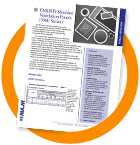What is the Difference between EMF and EMI?
“EMF” and “EMI” as terms are common in the electronics industry. For the most part, we give a pass to those who use them interchangeably. But it can lead to a bit of confusion, especially when it comes to engineering for, or requesting a solution for a project. Let’s set the record straight and then move into considerations for EMF protection.
EMF, or electromagnetic fields, are everywhere electricity or communication signals are present. It is stray or sometimes intentional energy, escaping the confines of the cables, wires and components in waves, or wave lengths. which vary depending on the source.
So, imagine in our technological world with gizmos and components wherever we turn, two electromagnetic energies competing for space, each seeking to overpower the other. It happens all the time, and the collision can cause serious problems. Remember when grandma turned on her old egg beater and the TV in the other room went fuzzy and the sound was crackling? That’s the result. In that case you have EMI, or electromagnetic interference. Now today, with our world dependent on electronics for everything, from medical devices to GPS systems to communication, problems produced by EMI can bring disastrous results. Systems quit; signals go astray.
If EMI is the result of EMF, what’s the big deal? Does it matter if we get the terms interchanged? Yes. Sometimes you want electromagnetic fields to be uninhibited. In that case EMI is the enemy. And sometimes EMI is purposeful, such as in military warfare. Knowing what you are trying to promote, capture or protect becomes the important language of EMF versus EMI.
As was the case with Grandma’s egg beater, we lived with this interplay of forces. Today we know to shield.
But Not All Electromagnetic Fields are Created Equally
This is definitely not a “one size fits all” situation. As alluded to above, various sources and applications emit various wavelengths of electromagnetic energy. Consider your particular energy source:
- Radio waves for data and voice operate at a particular frequency with longer wavelengths.
- Microwaves for heat, communications and radar.
- Infrared for thermal imaging driven by heat, some medical applications and, of course, heat itself.
These are just a few. Or, perhaps your particular project uses gamma, ultraviolet or x-rays.
Every one of these has their own frequency and their own wavelength. High frequencies will produce shorter wavelengths and vice versa. All of this must be taken into account, plus the location and purpose, when engineering for EMF or EMI shielding. For example, openings in a hardened enclosure must take into account the wavelength that your trying to disrupt. They must block signals during a wavelength so the interference cannot get through.
Different Strokes for Different Folks: Designing your EMF or EMI Shielding
Wavelength, in addition to the purpose you’re trying to achieve, determines how your EMI, EMF shielding or RF (radio frequency) shielding should be used.
- Are you building a hardened enclosure which needs to “blanket” the sensitive components inside from outside interference?
- Are you protecting individual components in the interior of an electronic box?
- Are you trying to protect nearby equipment from EMFs escaping from your equipment?
- Or, is purposeful emittance your goal, as in the case of some medical or military equipment?
On top of this, the effectiveness desired must be calculated… Commercial and Military projects can call for specifications, known as “SE” for shielding effectiveness. Various SE levels can be obtained by calculating the frequency vs SE desired using a calculator such as this one. Knowing this you can then determine the metals, rubbers or needed coatings in shielding materials.
The Unfilled Holes in Shielding
But that’s only the beginning. There are a lot of holes left to fill. Metals, conductive coatings, gaskets and all the way to ventilation filters; projects get derailed in the details by communicating with the wrong definition. EMI and EMF can easily get twisted. So, let the engineers at MAJR Products help you. With their vast understanding of how to achieve desired SE the right way, they can design a shielding solution. Connect with us to get started.


